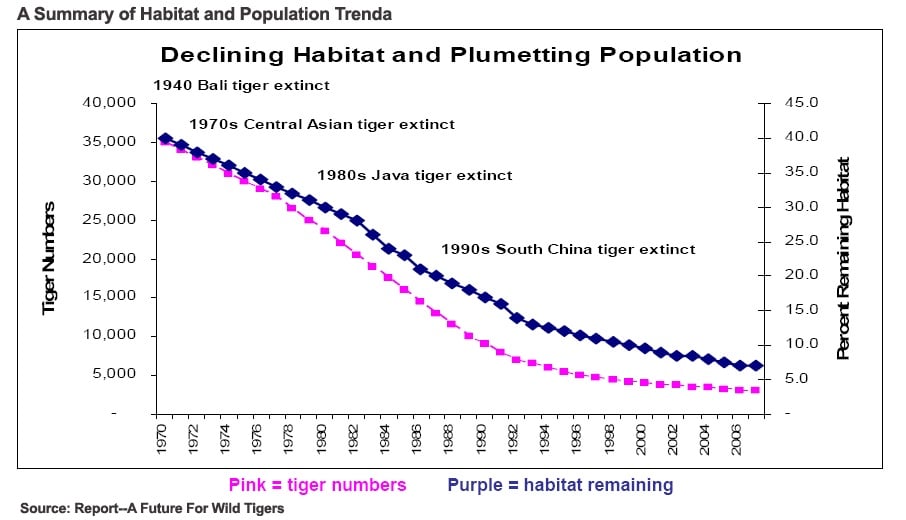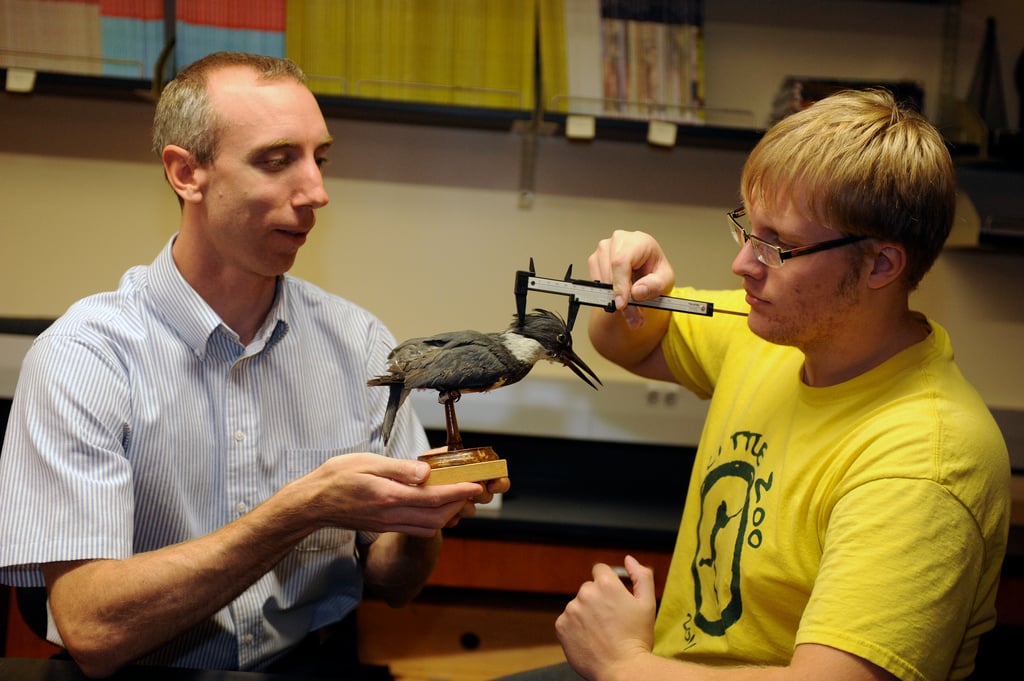This semester I am teaching a course called Endangered Species Conservation. I find that most people have no idea what a course with this title is about, so I’ll explain. First, an endangered species is an animal (or plant, or other living organism) that is exposed to one or more risk factors that could lead to the species’ extinction. Thus, a course on the conservation of endangered species should explore the reasons for the heightened risk and what can be done to lower it.
There are a large number of things that can contribute to extinction risk. A review of my syllabus shows we will discuss hunting, habitat loss, genetic problems related to small population size, human-introduced species that out-compete native wildlife, disease, climate change and many more. There are other ways to teach this course, but I find a species-centered approach is best for my student audience. This means I will use certain species as examples of a general pattern that will become more obvious as the semester goes on. For instance, I could talk about a species everyone has heard of—the tiger—and discuss what has caused it to be placed on a world-wide list of endangered species called the IUCN Red List (www.iucnredlist.org).
Later, as I discuss bats, birds and bearcats, the students will see that all three are impacted by similar threats, so solutions devised for one species can usually be modified for another. The bearcat (Arctictis binturong), by the way, is listed as “vulnerable” to extinction because its population is thought to have declined more than 30% over the last three generations (30 years). Current population numbers are not available today because very little research has been done on this species. The most recent studies are more than 10 years old. This is par for the course (a bit of a pun); there are so many species for which we have little data. We may lose these species from the Earth before we even get the chance to know them.
Conservation tends to concentrate on more popular animals like the tiger. The tiger (Panthera tigris) once lived throughout the Asian continent but is now found mostly in 8 countries: Bangladesh, Bhutan, India, Indonesia, Malaysia, Nepal, Russia and Thailand. Its population has declined more than 50% over the last three generations (21 years), and there are fewer than 2,500 mature individuals left (see graph). Hunting of tigers for meat, skin, bones, and other culturally valuable body parts remains the greatest threat, but habitat loss due to agriculture, logging, and human settlements is also having considerable impact.

As for any endangered species, the way forward is challenging. Potential solutions will involve a lot of cooperation and dialog between local peoples, non-governmental organizations and governmental agencies. Hunting and habitat loss cannot be prevented simply by tightening laws and regulations. Instead, government policies and practices relating to economics, health care and education will need to be adjusted. It’s a tough job; we need scientists, educators, economists, anthropologists and all kinds of other professionals at local, regional and international levels to come to a workable solution for each risk factor. A lot of money is needed, too. And all this assumes there is a human will to save the tiger or any other species from extinction.
What can we do in this country to protect the tiger, which lives halfway around the world? My answer is that we need experts in lots of fields to work on this, and we can give money to the cause, too. It strikes me every morning when I sit down to eat cereal for breakfast that Tony the Tiger could do a lot for conservation. Tony is the cartoon character featured on boxes of Kellogg’s Frosted Flakes. Do little kids and their parents who sit down with Tony realize that they may be the last human generations to live with tigers still present in the world?
Looking at some other breakfast characters, I see a bee on a box of Honey Nut Cheerios, a cuckoo bird on Cocoa Puffs, a frog on Honey Smacks, a silly rabbit on Trix, and Toucan Sam on Fruit Loops. I love the fact that animals are cultural icons like this. However, there are 8 species of endangered or vulnerable bees in the world (representing 31% of all bee species); 9 species of cuckoo (10% of all cuckoos); 1,713 species of frog (30% of all frogs); 12 species of rabbits (41% of all rabbits); and 8 species of toucan (50% of all toucans). If the cereal companies would dedicate a small paragraph to discussing the plight of these animals, it might go a long way in educating the public about the problem. It might also depress the little kids who eat the cereal, and they would cry, and their parents would no longer buy the product. But let us consider any and all ideas at this point, ok?
Conservation is a difficult thing to do. My role as a professor is to inform my students about these problems, teach them about possible solutions, and hope that some of them might pursue conservation interests within their academic specialties and future careers. We really need the creativity and expertise people bring from their own unique positions in society, whether they be artists, lawyers, biologists, horticulturalists or business executives. Society needs the energy that our young professionals will bring to their first jobs. We need leaders.
And that brings me to today’s 8:30am class. I arrived at 8:28am, a little later than I like, but still early enough to start on time. As I approached the classroom, I saw that the light was off. A moment of panic coursed through me—did I lose track of time, am I at the right room, where are my students?!
I walked into the room and saw that 23 students were sitting at their desks. The light was off. No one was talking. Some heads were down. Some phones were out. Silence. Void.
It took away my energy. Here I am, trying to be enthusiastic and excited to teach, and there were my students…just sitting there doing nothing…in the dark. No energy.
This is not the first class that I have found who sits in the dark, waiting for their professor to enter the room and flick on the light switch. But each time it happens, I get fearful. Who are these students? Do they have what it takes to become leaders of society? Who among them is willing to take the initiative and solve problems? Who is ready to turn on the light and start discussing things with the people around them? Today my students chose to sit passively in their seats waiting for me to give them energy and knowledge. But tomorrow I won’t be there, and what will the students do then?
Educators everywhere are familiar with the problem of treating students as vessels to fill up with knowledge. I am tempted every day to just throw factual information at my students, hoping they will learn some things. Of course, learning doesn’t happen that way. Learning requires professors who can engage students and students who participate as partners in the process. Learning is hard work. It is so tempting for a student to listen in class, read the text and look over their notes, but not really think about what they have read and heard. They think they are doing work, but they may not be doing the hardest work of organizing and integrating ideas in their brains. When students sit in a dark classroom waiting on the arrival of their professor, it might mean absolutely nothing. But it makes me wonder if they are prepared to do any work at all, even it’s just getting up and turning on a light switch.
My students would probably try to defend themselves by explaining “It is 8:30 in the morning! I don’t function before 11 a.m.!” But the problems of the day will not wait for us to grab a cup of coffee and lounge around until we feel like doing something. I feel strongly about conserving wild animals and their habitats. I love nature and cry when it is harmed. My students do not have to feel this way, but I hope they feel strongly about something. There are problems with our education system. There is crime and terrorism to worry about. Some will work toward improving the morals of society, or curing disease, or feeding and clothing the poor. There are countless other issues that threaten the Earth and all those who dwell within. Are my students prepared to work on these things? Will they be producers of ideas, rather than sedentary consumers of someone else’s work?
We cannot wait to solve these problems until we feel like it. We cannot solve these problems by ourselves. We have to arrive at school or at work and turn on the light. We have to sit up front rather than hiding in the back row. We have to turn away from mindless distractions (smart phones are useful, but the source of distraction, too). We must start talking to others, sharing ideas and experiences and figuring out what is important and what is not. That’s what it will take to make our world a better place. It’s a conscious choice to do so.
I have 13 more weeks in the semester to awaken my students to the challenges beyond and the rewards in life that come from their toil.
[Perhaps my writing is a little dramatic? Maybe it’s because I ate Frosted Flakes today.]


 中国学生
中国学生 Estudiantes
Estudiantes




